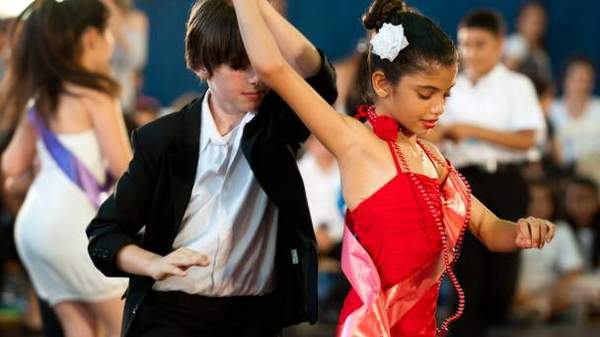Overview
In Hilla Medalia's charming documentary Dancing in Jaffa Pierre Dulaine goes to Jaffa in Israel with a seemingly impossible dream: to get Jewish and Palestinian children to dance together.
If anyone has the credentials to make this work Dulaine does. He is a four-time world champion ballroom dancer and is the founder of the United States based programme Dancing Classrooms. What's more the Jaffa native was born to a Palestinian mother. But his almost boundless optimism is put to the test by the considerable resistance he meets from students, and in some cases, from parents.
His idea is to teach ballroom dancing at Palestinian and Jewish schools, select the most talented students and then pair them up with kids from the other culture for a big dance competition. But some of the students are less than open to the idea. There are hilarious moments when some of the boys realise they're being asked to touch a girl. Their mouths drop in horror, they cover their hands with their sweatshirts and some outright refuse. On top of combating adolescent attitudes Dulaine must also convince the Muslim parents and then the students that when it comes to ballroom dancing it's okay for a girl to dance with a boy.
Because of his background Dulaine cares deeply about this project. He was just a child when his family was forced out to make way for the creation of Israel. Before the documentary was made he hadn’t returned to Jaffa for over 50 years. Despite this, when he stands in front of what was once his home he seems more sad than angry. He’s not there to dwell on his family's loss or take the property back. He just wants to share his passion for dance with both sides of the divide.
As well as focussing on Delaine's history Medalia gives us special access to the lives of three students. Noor, a Palestinian who is mourning the loss of her father and feels isolated from her classmates; Alaa, who comes from a very poor Palestinian family but always has a smile on his face and Lois, a confident and driven Jewish girl.
Medalia intersperses all this with footage of protests which show right-wing activists marching through the streets of Jaffa with anti-Arab signs. With all the jumping around from classrooms to students' homes to protests, the film can be a bit disjointed at times but the personal feel of the film is never lost. Even at the protests, we are there with Noor and her mother who are picketing against the protesters.
Watching friendships develop between the students and the culminating dance competition is an absolute joy to watch. Particularly poignant is a scene where the camera pans over the audience and you see Palestinian and Jewish parents sitting together and sharing in their excitement.
* This film is showing as part of Documentary Edge Festival 2014. Click here to see Concrete Playground picks from the programme
